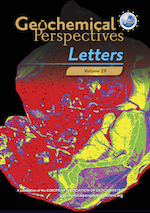Sulfur and mercury MIF suggest volcanic contributions to Earth’s atmosphere at 2.7 Ga
Affiliations | Corresponding Author | Cite as | Funding information- Share this article





-
Article views:210Cumulative count of HTML views and PDF downloads.
- Download Citation
- Rights & Permissions
top
Abstract
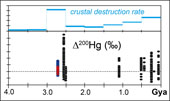
Figures
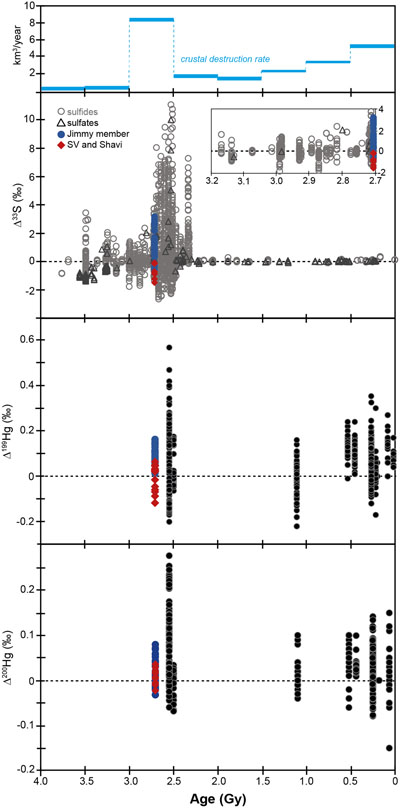 Figure 1 Temporal trends in S-MIF and Hg-MIF through time (updated from Farquhar et al., 2014, and Zerkle et al., 2020). Crustal destruction rates are modelled for 500 million year bins (Dhuime et al., 2018). | 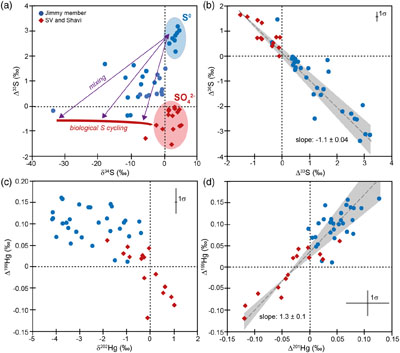 Figure 2 (a-d) Cross plots of S-MIF and Hg-MIF values. Panel (a) includes interpretations of S-MIF based on the conventional view of sulfur exit channels (but see Harman et al., 2018, for an alternative view). Panels (b) and (d) include orthogonal data regressions, showing the calculated linear slopes (gray dashed line) and 3σ confidence intervals (gray blue area). The Δ36S/Δ33S slope is consistent with the Archean reference array (Ono et al., 2009); the Δ199Hg/Δ201Hg slope is consistent with production of odd number Hg-MIF during Hg2+ photo-reduction (Bergquist and Blum, 2007). | 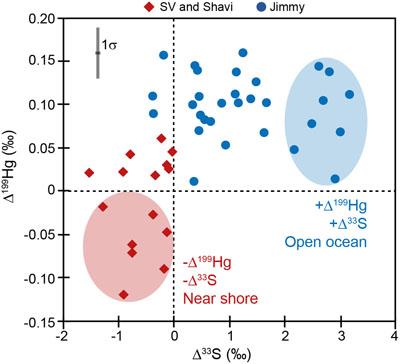 Figure 3 Trends in S-MIF versus Hg-MIF, with associated interpretations based on comparison with modern sedimentary Hg-MIF values. |
| Figure 1 | Figure 2 | Figure 3 |
top
Introduction
The mid- to late-Archean, between ∼3.2 and 2.5 billion years ago (Gyr), was a time of great transitions in Earth history, including the evolutionary proliferation of cyanobacteria performing oxygenic photosynthesis (Farquhar et al., 2011
Farquhar, J., Zerkle, A.L., Bekker, A. (2011) Geological constraints on the origin of oxygenic photosynthesis. Photosynthesis Research 107, 11–36.
; Nisbet and Fowler, 2014Nisbet, E.G., Fowler, C.M.R. (2014) 10.1 - The Early History of Life. In: Holland, H.D., Turekian, K.K. (Eds.) Treatise on Geochemistry. Second Edition, Elsevier, Oxford, 1–42.
) and the development of plate tectonics (Hawkesworth et al., 2020Hawkesworth, C.J., Cawood, P.A., Dhuime, B. (2020) The evolution of the continental crust and the onset of plate tectonics. Frontiers in Earth Science 8.
). Both of these events would have fundamentally altered Earth’s surface environments and planetary habitability, the former by introducing a strong oxidant, and the latter by modulating fluxes of carbon and other volatile elements between the mantle and the surface (Zerkle, 2018Zerkle, A.L. (2018) Biogeodynamics: bridging the gap between surface and deep Earth processes. Philosophical Transactions of the Royal Society A 376, 20170401.
). Although geosphere-biosphere-atmosphere feedbacks would have been essential in driving (and responding to) these critical changes in Earth’s history, geochemical markers that place direct constraints on atmospheric evolution during this time period remain elusive.Mass independent fractionation of sulfur isotopes (S-MIF) provide vital clues into past atmospheric chemistry. The presence of large magnitude S-MIF in rocks deposited prior to ∼2.43 Ga provides compelling evidence for an oxygen-poor atmosphere in the Archean and early Palaeoproterozoic (Farquhar et al., 2000
Farquhar, J., Bao, H.M., Thiemens, M. (2000) Atmospheric influence of Earth’s earliest sulfur cycle. Science 289, 756–758.
; Warke et al., 2020Warke, M.R., Di Rocco, T., Zerkle, A.L., Lepland, A., Prave, A.R., Martin, A., Ueno, Y., Condon, D.J., Claire, M. (2020) The Great Oxidation Event preceded a Paleoproterozoic “snowball Earth”. PNAS 117, 13314–13320.
). The S-MIF record also displays significant variations in magnitude, sign, and quadruple S isotope systematics (expressed as Δ33S and Δ36S; Eqs. S-2, S-3) that could provide additional constraints on Earth’s reducing atmosphere. In particular, a decrease in the magnitude of S-MIF has been reported in Archean rocks deposited between ∼3.2 and 2.7 Ga (Fig. 1). This “mid-Archean MIF minimum” has been variably attributed to changes in global atmospheric chemistry, which could shield or dampen S-MIF forming reactions (Farquhar et al., 2007Farquhar, J., Peters, M., Johnston, D.T., Strauss, H., Masterson, A., Wiechert, U., Kaufman, A.J. (2007) Isotopic evidence for Mesoarchaean anoxia and changing atmospheric sulphur chemistry. Nature 449, 706–709.
; Domagal-Goldman et al., 2008Domagal-Goldman, S.D., Kasting, J.F., Johnston, D.T., Farquhar, J. (2008) Organic haze, glaciations and multiple sulfur isotopes in the Mid-Archean Era. Earth and Planetary Science Letters 269, 29–40.
; Kurzweil et al., 2013Kurzweil, F., Claire, M.W., Thomazo, C., Peters, M., Hannington, M.D., Strauss, H. (2013) Atmospheric sulfur rearrangement 2.7 billion years ago: Evidence for oxygenic photosynthesis. Earth and Planetary Science Letters 366, 17–26.
; Liu et al., 2019Liu, P., Harman, C.E., Kasting, J.F., Hu, Y., Wang, J. (2019) Can organic haze and O2 plumes explain patterns of sulfur mass-independent fractionation during the Archean? Earth and Planetary Science Letters 526, 115767.
), or to dilution or mixing of atmospheric sulfur sources on a local or regional scale (Guy et al., 2012Guy, B.M., Ono, S., Gutzmer, J., Kaufman, A., Lin, Y., Fogel, M., Beukes, N. (2012) A multiple sulfur and organic carbon isotope record from non-conglomeratic sedimentary rocks of the Mesoarchean Witwatersrand Supergroup, South Africa. Precambrian Research 216-219, 208–231.
; Thomazo et al., 2013Thomazo, C., Grassineau, N.V., Nisbet, E.G., Peters, M., Strauss, H. (2013) Multiple sulfur and carbon isotope composition of sediments from the Belingwe Greenstone Belt (Zimbabwe): A biogenic methane regulation on mass independent fractionation of sulfur during the Neoarchean? Geochimica et Cosmochimica Acta 121, 120–138.
; Marin-Carbonne et al., 2014Marin-Carbonne, J., Rollion-Bard, C., Bekker, A., Rouxel, O., Agangi, A., Cavalazzi, B., Wohlgemuth-Ueberwasser, C.C., Hofmann, A., McKeegan, K.D. (2014) Coupled Fe and S isotope variations in pyrite nodules from Archean shale. Earth and Planetary Science Letters 392, 67–79.
).
Figure 1 Temporal trends in S-MIF and Hg-MIF through time (updated from Farquhar et al., 2014
Farquhar, J., Zerkle, A.L., Bekker, A. (2014) 6.4 - Geologic and Geochemical Constraints on the Earth’s Early Atmosphere. In: Holland, H.D., Turekian, K.K. (Eds.) Treatise on Geochemistry. Second Edition, Elsevier, Oxford, 91–138.
, and Zerkle et al., 2020Zerkle, A.L., Yin, R., Chen, C., Li, X., Izon, G., Grasby, S. (2020) Anomalous fractionation of mercury isotopes in the Late Archean atmosphere. Nature Communications 11, 1709.
). Crustal destruction rates are modelled for 500 million year bins (Dhuime et al., 2018Dhuime, B., Hawkesworth, C.J., Delavault, H., Cawood, P.A. (2018) Rates of generation and destruction of the continental crust: implications for continental growth. Philosophical Transactions of the Royal Society A 376.
).MIF of mercury (Hg) isotopes in marine sediments can provide additional constraints on atmospheric chemistry. Mercury undergoes MIF of both odd number isotopes (expressed as Δ199Hg and Δ201Hg; Eq. S-5) and even number isotopes (expressed as Δ200Hg) during Hg transformations between the atmosphere and oceans (Blum et al., 2014
Blum, J.D., Sherman, L.S., Johnson, M.W. (2014) Mercury isotopes in earth and environmental sciences. Annual Review of Earth and Planetary Sciences 42, 249–269.
). Odd number Hg-MIF is predominatly produced by photo-reduction of aqueous Hg2+, which occurs mainly in the surface ocean but also in rain droplets (Bergquist and Blum, 2007Bergquist, B.A., Blum, J.D. (2007) Mass-dependent and -independent fractionation of Hg isotopes by photoreduction in aquatic systems. Science 318, 417–420.
). By contrast, even number Hg-MIF is only produced during gas phase Hg0 photo-oxidation in the atmosphere (Cai and Chen, 2016Cai, H.M., Chen, J.B. (2016) Mass-independent fractionation of even mercury isotopes. Science Bulletin 61, 116–124.
). In the oceans, MIF-bearing Hg complexes with organic matter and sulfur ligands and is deposited in the sediments. The resulting Hg-MIF signals are robust to post-depositional alteration (Grasby et al., 2016Grasby, S.E., Shen, W., Yin, R., Gleason, J.D., Blum, J.D., Lepak, R.F., Hurley, J.P., Beauchamp, B. (2016) Isotopic signatures of mercury contamination in latest Permian oceans. Geology 45, 55–58.
) and can record additional, complementary atmospheric constraints (Zerkle et al., 2020Zerkle, A.L., Yin, R., Chen, C., Li, X., Izon, G., Grasby, S. (2020) Anomalous fractionation of mercury isotopes in the Late Archean atmosphere. Nature Communications 11, 1709.
). Here we present coupled records of S-MIF and Hg-MIF data from well preserved sediments of the ∼2.7 Ga Manjeri Formation of the Belingwe Greenstone Belt, Zimbabwe, to determine local versus global controls on MIF records, and to unravel drivers of Archean atmospheric chemistry.top
Sulfur and Mercury MIF in the Manjeri Formation
Our samples were collected from three drill cores through the ∼2.7 Ga Manjeri Formation (Fm) of the Belingwe Greenstone Belt, Zimbabwe (as detailed in Yang et al., 2019
Yang, J., Junium, C.K., Grassineau, N.V., Nisbet, E.G., Izon, G., Mettam, C., Martin, A., Zerkle, A.L. (2019) Ammonium availability in the Late Archaean nitrogen cycle. Nature Geoscience 12, 553–557.
, and SI). This section of the Manjeri Fm (Hunter et al., 1998Hunter, M.A., Bickle, M.J., Nisbet, E.G., Martin, A., Chapman, H.J. (1998) Continental extensional setting for the Archean Belingwe Greenstone Belt, Zimbabwe. Geology 26, 883–886.
) records a marine transgression from a basal unconformity and the intertidal facies of the Spring Valley (SV) member, through the subtidal Shavi member (preserved in the NERCMAR core) to the deeper water shales of the Jimmy member (preserved in cores A and B).S-MIF from the Manjeri Fm had Δ33S values ranging from -1.5 to +3.1 ‰, with positive Δ33S values dominating the Jimmy member and negative Δ33S values dominating the Spring Valley and Shavi members (Fig. 2). These S-MIF values are larger in magnitude than bulk rock Δ33S values previously reporteded from ∼2.7 Ga (e.g., Thomazo et al., 2013
Thomazo, C., Grassineau, N.V., Nisbet, E.G., Peters, M., Strauss, H. (2013) Multiple sulfur and carbon isotope composition of sediments from the Belingwe Greenstone Belt (Zimbabwe): A biogenic methane regulation on mass independent fractionation of sulfur during the Neoarchean? Geochimica et Cosmochimica Acta 121, 120–138.
), but still significantly smaller than Δ33S values preserved in ∼2.5 Ga sediments (Fig. 1). Shielding of S-MIF forming reactions by oxygen or organic haze have been proposed to erase or decrease S-MIF (Domagal-Goldman et al., 2008Domagal-Goldman, S.D., Kasting, J.F., Johnston, D.T., Farquhar, J. (2008) Organic haze, glaciations and multiple sulfur isotopes in the Mid-Archean Era. Earth and Planetary Science Letters 269, 29–40.
; Kurzweil et al., 2013Kurzweil, F., Claire, M.W., Thomazo, C., Peters, M., Hannington, M.D., Strauss, H. (2013) Atmospheric sulfur rearrangement 2.7 billion years ago: Evidence for oxygenic photosynthesis. Earth and Planetary Science Letters 366, 17–26.
; Liu et al., 2019Liu, P., Harman, C.E., Kasting, J.F., Hu, Y., Wang, J. (2019) Can organic haze and O2 plumes explain patterns of sulfur mass-independent fractionation during the Archean? Earth and Planetary Science Letters 526, 115767.
), but the persistence of S-MIF in these samples precludes an ozone layer, and the Δ36S-Δ33S dynamics are inconsistent with haze formation (Fig. 2b) (Zerkle et al., 2012Zerkle, A.L., Claire, M.W., Domagal-Goldman, S.D., Farquhar, J., Poulton, S.W. (2012) A bistable organic-rich atmosphere on the Neoarchean Earth. Nature Geoscience 5, 359–363.
). Modelling studies have shown that higher total volcanic sulfur fluxes can alter sulfur exit channels and decrease S-MIF values (Claire et al., 2014Claire, M.W., Kasting, J.F., Domagal-Goldman, S.D., Stueken, E.E., Buick, R., Meadows, V.S. (2014) Modeling the signature of sulfur mass-independent fractionation produced in the Archean atmosphere. Geochimica et Cosmochimica Acta 141, 365–380.
), providing one potential explanation for lower magnitude atmospheric S-MIF.
Figure 2 (a-d) Cross plots of S-MIF and Hg-MIF values. Panel (a) includes interpretations of S-MIF based on the conventional view of sulfur exit channels (but see Harman et al., 2018
Harman, C.E., Pavlov, A., Babikov, D., Kasting, J.F. (2018) Chain formation as a mechanism for mass-independent fractionation of sulfur isotopes in the Archean atmosphere. Earth and Planetary Science Letters 496, 238–247.
, for an alternative view). Panels (b) and (d) include orthogonal data regressions, showing the calculated linear slopes (gray dashed line) and 3σ confidence intervals (gray blue area). The Δ36S/Δ33S slope is consistent with the Archean reference array (Ono et al., 2009Ono, S., Beukes, N.J., Rumble, D. (2009) Origin of two distinct multiple-sulfur isotope compositions of pyrite in the 2.5 Ga Klein Naute Formation, Griqualand West Basin, South Afric. Precambrian Research 169, 48–57.
); the Δ199Hg/Δ201Hg slope is consistent with production of odd number Hg-MIF during Hg2+ photo-reduction (Bergquist and Blum, 2007Bergquist, B.A., Blum, J.D. (2007) Mass-dependent and -independent fractionation of Hg isotopes by photoreduction in aquatic systems. Science 318, 417–420.
).Local- or basinal-scale mixing of primary atmospheric S sources can further dampen sedimentary S-MIF signals (e.g., Marin-Carbonne et al., 2014
Marin-Carbonne, J., Rollion-Bard, C., Bekker, A., Rouxel, O., Agangi, A., Cavalazzi, B., Wohlgemuth-Ueberwasser, C.C., Hofmann, A., McKeegan, K.D. (2014) Coupled Fe and S isotope variations in pyrite nodules from Archean shale. Earth and Planetary Science Letters 392, 67–79.
). Following mass balance, the preservation of S-MIF in ancient sediments requires two or more exit channels for atmospheric sulfur, conventionally considered to be elemental sulfur carrying a positive Δ33S signature (as seen in the Jimmy member) and sulfate carrying a negative Δ33S signal (as seen in the SV and Shavi members), although this remains debated (Claire et al., 2014Claire, M.W., Kasting, J.F., Domagal-Goldman, S.D., Stueken, E.E., Buick, R., Meadows, V.S. (2014) Modeling the signature of sulfur mass-independent fractionation produced in the Archean atmosphere. Geochimica et Cosmochimica Acta 141, 365–380.
; Harman et al., 2018Harman, C.E., Pavlov, A., Babikov, D., Kasting, J.F. (2018) Chain formation as a mechanism for mass-independent fractionation of sulfur isotopes in the Archean atmosphere. Earth and Planetary Science Letters 496, 238–247.
). In particular, the very small S-MIF in some samples from the Jimmy member (with Δ33S < 2 ‰) could reflect further muting of primary atmospheric S-MIF values via mixing. Mixing could have been driven by biological processes (e.g., through re-oxidation of reduced S), physical processes (e.g., mixing of Fe-sulfides derived from sulfate reduction with polysulfides to form pyrite), or some combination of both (Fig. 2a). Previous studies indicate that Jimmy member sediments supported an active biogeochemical S cycle in proximity to a redox interface (Yang et al., 2019Yang, J., Junium, C.K., Grassineau, N.V., Nisbet, E.G., Izon, G., Mettam, C., Martin, A., Zerkle, A.L. (2019) Ammonium availability in the Late Archaean nitrogen cycle. Nature Geoscience 12, 553–557.
), consistent with this interpretation.Mercury isotopes provide new insights into environmental conditions during deposition of the Manjeri strata. δ202Hg values alone are difficult to interpret, since mass dependent fractionation of Hg occurs during all Hg cycling processes (Blum et al., 2014
Blum, J.D., Sherman, L.S., Johnson, M.W. (2014) Mercury isotopes in earth and environmental sciences. Annual Review of Earth and Planetary Sciences 42, 249–269.
). In contrast, mercury MIF provides clearer constraints on atmospheric Hg cycling, as it mainly occurs during photon-mediated processes with little contribution from biogeochemical cycling, and even number Hg-MIF is produced exclusively in the atmosphere. Odd number Hg-MIF from the Manjeri Fm support two sources of Hg to the sediments, one dominated by positive odd number Hg-MIF, and one dominated by negative odd number Hg-MIF (Fig. 2c). In the modern environment, rain and open marine samples that mainly contain Hg2+ species are characterised by positive odd number Hg-MIF (e.g., Štrok et al., 2015Štrok, M., Baya, P.A., Hintelmann, H. (2015) The mercury isotope composition of Arctic coastal seawater. Comptes Rendus Geoscience 347, 368–376.
), while terrestrial reservoirs and modern coastal sediments that primarily accumulate Hg0 are characterised by negative odd number Hg-MIF (Blum et al., 2014Blum, J.D., Sherman, L.S., Johnson, M.W. (2014) Mercury isotopes in earth and environmental sciences. Annual Review of Earth and Planetary Sciences 42, 249–269.
). These Hg-MIF values therefore suggest that the dominant source of Hg to the SV and Shavi members was Hg0 species deposited in a shallow depositional environment, where enhanced terrestrial nutrient input stimulated local primary productivity, driving near shore anoxia. The Jimmy member, on the other hand, was dominated by Hg2+ species deposited in a more oligotrophic open ocean environment, adjacent to a deeper water chemocline. This depositional scenario is supported by previously published sedimentology (Hunter et al., 1998Hunter, M.A., Bickle, M.J., Nisbet, E.G., Martin, A., Chapman, H.J. (1998) Continental extensional setting for the Archean Belingwe Greenstone Belt, Zimbabwe. Geology 26, 883–886.
) and ocean redox data from these same cores (Yang et al., 2019Yang, J., Junium, C.K., Grassineau, N.V., Nisbet, E.G., Izon, G., Mettam, C., Martin, A., Zerkle, A.L. (2019) Ammonium availability in the Late Archaean nitrogen cycle. Nature Geoscience 12, 553–557.
). Combined S-MIF and Hg-MIF data also indicate that the atmospheric exit channel carrying a negative Δ33S signal dominated the S pool in shallow, near shore environments, while atmospheric S carrying a positive Δ33S signal dominated in open ocean environments (Fig. 3).
Figure 3 Trends in S-MIF versus Hg-MIF, with associated interpretations based on comparison with modern sedimentary Hg-MIF values.
Similar to S-MIF, Hg-MIF values from the 2.7 Ga Belingwe strata are muted (odd number Hg-MIF) or completely absent (even number Hg-MIF) in comparison to Hg-MIF data from the later Archean (Fig. 1). A decrease in the magnitude of sedimentary Hg-MIF towards values of 0 ‰ is generally attributed to enhanced atmospheric flux of vocanically-derived Hg0 to the sediments, since volcanic Hg0 has Δ199Hg and Δ200Hg values of 0 ‰ (Zambardi et al., 2009
Zambardi, T., Sonke, J.E., Toutain, J.P., Sortino, F., Shinohara, H. (2009) Mercury emissions and stable isotopic compositions at Vulcano Island (Italy). Earth and Planetary Science Letters 277, 236–243.
). Ratios of mercury to TOC in the Manjeri Fm support high volcanic Hg0 inputs to the sediments, particularly in the near shore SV and Shavi members (1274 ± 584 ppb Hg/wt. % TOC; Grasby et al., 2019Grasby, S.E., Them II, T.R., Chen, Z., Yin, R., Ardakani, O.H. (2019) Mercury as a proxy for volcanic emmisions in the geologic record. Earth Science Reviews 196, 102880.
). However, volcanic Hg0 input would affect both odd number and even number Hg-MIF similarly, as would any post-depositional mixing processes, so neither of these mechanisms can explain the entirety of our Hg-MIF data.The complete absence of even number Hg-MIF in these sediments instead requires further alteration of the photo-oxidation processes that uniquely produce Δ200Hg anomalies. The dominant oxidation pathway for Hg0 in the modern atmosphere is reaction with halogens, such as bromine and chlorine (Dibble et al., 2020
Dibble, T.S., Tetu, H.L., Jiao, Y.G., Thackray, C.P., Jacob, D.J. (2020) Modeling the OH-Initiated Oxidation of Mercury in the Global Atmosphere without Violating Physical Laws. Journal of Physical Chemistry A 124, 444–453.
), and these reactions have been shown to produce even number Hg-MIF (Sun et al., 2016Sun, G., Sommar, J., Feng, X., Lin, C.-J., Ge, M., Wang, W., Yin, R., Fu, X., Shang, L. (2016) Mass-dependent and independent fractionation of mercury isotopes during gas-phase oxidation of elemental mercury vapor by atomic Cl and Br. Environmental Science & Technology 50, 9232–9241.
). In the modern Earth system, the largest volcanic source of halogens is from subduction zone-related arc volcanism (Pyle and Mather, 2009Pyle, D.M., Mather, T.A. (2009) Halogens in igneous processes and their fluxes to the atmosphere and oceans from volcanic activity: A review. Chemical Geology 263, 110–121.
). Enhanced volcanic fluxes of SO2 and halogens into the atmosphere could have driven Hg0 photo-oxidation reactions near to completion, as seen with seasonal atmospheric mercury depletion events that occur in modern polar regions (Carignan and Sonke, 2010Carignan, J., Sonke, J.E. (2010) The effect of atmospheric mercury depletion events on the net deposition flux around Hudson Bay, Canada. Atmospheric Environment 44, 4372–4379.
), erasing any even number Hg-MIF signal. Halogens could have additionally been supplied from komatiitic volcanism, as indicated by the overlying Zeederbers Fm deposited several million years later (Cameron et al., 1979Cameron, W.E., Nisbet, E.G., Dietrich, V.J. (1979) Boninites, komatiites, and ophiolitic basalts. Nature 280.
).Enhanced global volcanic gas fluxes could have contributed both MIF-free sulfur and mercury to the sediments, diluting the overall magnitudes of sedimentary MIF. In addition, the complete lack of even number Hg-MIF in these sediments suggests a volcanic source rich in halogens, similar to modern arc volcanism. Therefore, enhanced arc volcanism provides the only self-consistent mechanism that can reconcile all three sets of MIF records. Within a global geodynamic context, models of continental crust formation suggest that crustal destruction rates increased dramatically at ∼3.0 Ga, inferred to represent the widespread development of subduction zones (Fig. 1) (Dhuime et al., 2018
Dhuime, B., Hawkesworth, C.J., Delavault, H., Cawood, P.A. (2018) Rates of generation and destruction of the continental crust: implications for continental growth. Philosophical Transactions of the Royal Society A 376.
). The increase in crustal destruction rates, coupled with the development and amalgamation of Archean supercontinents, are taken to reflect the onset of plate tectonics as the dominant global regime during this time (Hawkesworth et al., 2020Hawkesworth, C.J., Cawood, P.A., Dhuime, B. (2020) The evolution of the continental crust and the onset of plate tectonics. Frontiers in Earth Science 8.
). Our data are consistent with enhanced volatile fluxes from subduction zone arc volcanism at ∼2.7 Ga. Following this scenario, the increase in S-MIF and Hg-MIF between 2.7 and 2.5 Ga could be explained by decreased volcanic emissions during the transition to tectonic quiescence in the Palaeoproterozoic (Cawood and Hawkesworth, 2014Cawood, P.A., Hawkesworth, C.J. (2014) Earth’s middle age. Geology 42, 503–506.
). As a corollary, the time span of the mid-Archean S-MIF minimum could indicate that volcanic emissions from plate tectonics exerted a fundamental control on atmospheric chemistry from ∼3.2 to 2.7 Ga, before biology wrested control in the ensuing ∼200 million years (e.g., Kurzweil et al., 2013Kurzweil, F., Claire, M.W., Thomazo, C., Peters, M., Hannington, M.D., Strauss, H. (2013) Atmospheric sulfur rearrangement 2.7 billion years ago: Evidence for oxygenic photosynthesis. Earth and Planetary Science Letters 366, 17–26.
; Izon et al., 2017Izon, G., Zerkle, A.L., Williford, K.H., Farquhar, J., Poulton, S.W., Claire, M.W. (2017) Biological regulation of atmospheric chemistry en route to planetary oxygenation. PNAS 114, 2571–2579.
).top
Acknowledgements
This study received funding from a Natural Environment Research Council Standard Grant NE/M001156/1 (ALZ, EGN), and from the European Research Council under the European Union’s Horizon 2020 research and innovation programme (Grant 678812 to MWC). RS and RY were supported by the Natural Science Foundation of China (41873047).
Editor: Gavin Foster
top
References
Bergquist, B.A., Blum, J.D. (2007) Mass-dependent and -independent fractionation of Hg isotopes by photoreduction in aquatic systems. Science 318, 417–420.
 Show in context
Show in context Odd number Hg-MIF is predominatly produced by photo-reduction of aqueous Hg2+, which occurs mainly in the surface ocean but also in rain droplets (Bergquist and Blum, 2007).
View in article
The Δ36S/Δ33S slope is consistent with the Archean reference array (Ono et al., 2009); the Δ199Hg/Δ201Hg slope is consistent with production of odd number Hg-MIF during Hg2+ photo-reduction (Bergquist and Blum, 2007).
View in article
Blum, J.D., Sherman, L.S., Johnson, M.W. (2014) Mercury isotopes in earth and environmental sciences. Annual Review of Earth and Planetary Sciences 42, 249–269.
 Show in context
Show in context MIF of mercury (Hg) isotopes in marine sediments can provide additional constraints on atmospheric chemistry. Mercury undergoes MIF of both odd number isotopes (expressed as Δ199Hg and Δ201Hg; Eq. S-5) and even number isotopes (expressed as Δ200Hg) during Hg transformations between the atmosphere and oceans (Blum et al., 2014).
View in article
δ202Hg values alone are difficult to interpret, since mass dependent fractionation of Hg occurs during all Hg cycling processes (Blum et al., 2014).
View in article
In the modern environment, rain and open marine samples that mainly contain Hg2+ species are characterised by positive odd number Hg-MIF (e.g., Štrok et al., 2015), while terrestrial reservoirs and modern coastal sediments that primarily accumulate Hg0 are characterised by negative odd number Hg-MIF (Blum et al., 2014).
View in article
Cai, H.M., Chen, J.B. (2016) Mass-independent fractionation of even mercury isotopes. Science Bulletin 61, 116–124.
 Show in context
Show in context By contrast, even number Hg-MIF is only produced during gas phase Hg0 photo-oxidation in the atmosphere (Cai and Chen, 2016).
View in article
Cameron, W.E., Nisbet, E.G., Dietrich, V.J. (1979) Boninites, komatiites, and ophiolitic basalts. Nature 280.
 Show in context
Show in context Enhanced volcanic fluxes of SO2 and halogens into the atmosphere could have driven Hg0 photo-oxidation reactions near to completion, as seen with seasonal atmospheric mercury depletion events that occur in modern polar regions (Carignan and Sonke, 2010), erasing any even number Hg-MIF signal. Halogens could have additionally been supplied from komatiitic volcanism, as indicated by the overlying Zeederbers Fm deposited several million years later (Cameron et al., 1979).
View in article
Carignan, J., Sonke, J.E. (2010) The effect of atmospheric mercury depletion events on the net deposition flux around Hudson Bay, Canada. Atmospheric Environment 44, 4372–4379.
 Show in context
Show in context Enhanced volcanic fluxes of SO2 and halogens into the atmosphere could have driven Hg0 photo-oxidation reactions near to completion, as seen with seasonal atmospheric mercury depletion events that occur in modern polar regions (Carignan and Sonke, 2010), erasing any even number Hg-MIF signal. Halogens could have additionally been supplied from komatiitic volcanism, as indicated by the overlying Zeederbers Fm deposited several million years later (Cameron et al., 1979).
View in article
Cawood, P.A., Hawkesworth, C.J. (2014) Earth’s middle age. Geology 42, 503–506.
 Show in context
Show in context Following this scenario, the increase in S-MIF and Hg-MIF between 2.7 and 2.5 Ga could be explained by decreased volcanic emissions during the transition to tectonic quiescence in the Palaeoproterozoic (Cawood and Hawkesworth, 2014).
View in article
Claire, M.W., Kasting, J.F., Domagal-Goldman, S.D., Stueken, E.E., Buick, R., Meadows, V.S. (2014) Modeling the signature of sulfur mass-independent fractionation produced in the Archean atmosphere. Geochimica et Cosmochimica Acta 141, 365–380.
 Show in context
Show in context Modelling studies have shown that higher total volcanic sulfur fluxes can alter sulfur exit channels and decrease S-MIF values (Claire et al., 2014), providing one potential explanation for lower magnitude atmospheric S-MIF.
View in article
Following mass balance, the preservation of S-MIF in ancient sediments requires two or more exit channels for atmospheric sulfur, conventionally considered to be elemental sulfur carrying a positive Δ33S signature (as seen in the Jimmy member) and sulfate carrying a negative Δ33S signal (as seen in the SV and Shavi members), although this remains debated (Claire et al., 2014; Harman et al., 2018).
View in article
Dhuime, B., Hawkesworth, C.J., Delavault, H., Cawood, P.A. (2018) Rates of generation and destruction of the continental crust: implications for continental growth. Philosophical Transactions of the Royal Society A 376.
 Show in context
Show in context Within a global geodynamic context, models of continental crust formation suggest that crustal destruction rates increased dramatically at ∼3.0 Ga, inferred to represent the widespread development of subduction zones (Fig. 1) (Dhuime et al., 2018).
View in article
Temporal trends in S-MIF and Hg-MIF through time (updated from Farquhar et al., 2014, and Zerkle et al., 2020). Crustal destruction rates are modelled for 500 million year bins (Dhuime et al., 2018).
View in article
Dibble, T.S., Tetu, H.L., Jiao, Y.G., Thackray, C.P., Jacob, D.J. (2020) Modeling the OH-Initiated Oxidation of Mercury in the Global Atmosphere without Violating Physical Laws. Journal of Physical Chemistry A 124, 444–453.
 Show in context
Show in context The dominant oxidation pathway for Hg0 in the modern atmosphere is reaction with halogens, such as bromine and chlorine (Dibble et al., 2020), and these reactions have been shown to produce even number Hg-MIF (Sun et al., 2016).
View in article
Domagal-Goldman, S.D., Kasting, J.F., Johnston, D.T., Farquhar, J. (2008) Organic haze, glaciations and multiple sulfur isotopes in the Mid-Archean Era. Earth and Planetary Science Letters 269, 29–40.
 Show in context
Show in context Shielding of S-MIF forming reactions by oxygen or organic haze have been proposed to erase or decrease S-MIF (Domagal-Goldman et al., 2008; Kurzweil et al., 2013; Liu et al., 2019), but the persistence of S-MIF in these samples precludes an ozone layer, and the Δ36S-Δ33S dynamics are inconsistent with haze formation (Fig. 2b) (Zerkle et al., 2012).
View in article
This “mid-Archean MIF minimum” has been variably attributed to changes in global atmospheric chemistry, which could shield or dampen S-MIF forming reactions (Farquhar et al., 2007; Domagal-Goldman et al., 2008; Kurzweil et al., 2013; Liu et al., 2019), or to dilution or mixing of atmospheric sulfur sources on a local or regional scale (Guy et al., 2012; Thomazo et al., 2013; Marin-Carbonne et al., 2014).
View in article
Farquhar, J., Bao, H.M., Thiemens, M. (2000) Atmospheric influence of Earth’s earliest sulfur cycle. Science 289, 756–758.
 Show in context
Show in context Mass independent fractionation of sulfur isotopes (S-MIF) provide vital clues into past atmospheric chemistry. The presence of large magnitude S-MIF in rocks deposited prior to ∼2.43 Ga provides compelling evidence for an oxygen-poor atmosphere in the Archean and early Palaeoproterozoic (Farquhar et al., 2000; Warke et al., 2020).
View in article
Farquhar, J., Peters, M., Johnston, D.T., Strauss, H., Masterson, A., Wiechert, U., Kaufman, A.J. (2007) Isotopic evidence for Mesoarchaean anoxia and changing atmospheric sulphur chemistry. Nature 449, 706–709.
 Show in context
Show in context This “mid-Archean MIF minimum” has been variably attributed to changes in global atmospheric chemistry, which could shield or dampen S-MIF forming reactions (Farquhar et al., 2007; Domagal-Goldman et al., 2008; Kurzweil et al., 2013; Liu et al., 2019), or to dilution or mixing of atmospheric sulfur sources on a local or regional scale (Guy et al., 2012; Thomazo et al., 2013; Marin-Carbonne et al., 2014).
View in article
Farquhar, J., Zerkle, A.L., Bekker, A. (2011) Geological constraints on the origin of oxygenic photosynthesis. Photosynthesis Research 107, 11–36.
 Show in context
Show in context The mid- to late-Archean, between ∼3.2 and 2.5 billion years ago (Gyr), was a time of great transitions in Earth history, including the evolutionary proliferation of cyanobacteria performing oxygenic photosynthesis (Farquhar et al., 2011; Nisbet and Fowler, 2014) and the development of plate tectonics (Hawkesworth et al., 2020).
View in article
Farquhar, J., Zerkle, A.L., Bekker, A. (2014) 6.4 - Geologic and Geochemical Constraints on the Earth’s Early Atmosphere. In: Holland, H.D., Turekian, K.K. (Eds.) Treatise on Geochemistry. Second Edition, Elsevier, Oxford, 91–138.
 Show in context
Show in context Temporal trends in S-MIF and Hg-MIF through time (updated from Farquhar et al., 2014, and Zerkle et al., 2020). Crustal destruction rates are modelled for 500 million year bins (Dhuime et al., 2018).
View in article
Grasby, S.E., Shen, W., Yin, R., Gleason, J.D., Blum, J.D., Lepak, R.F., Hurley, J.P., Beauchamp, B. (2016) Isotopic signatures of mercury contamination in latest Permian oceans. Geology 45, 55–58.
 Show in context
Show in context In the oceans, MIF-bearing Hg complexes with organic matter and sulfur ligands and is deposited in the sediments. The resulting Hg-MIF signals are robust to post-depositional alteration (Grasby et al., 2016) and can record additional, complementary atmospheric constraints (Zerkle et al., 2020).
View in article
Grasby, S.E., Them II, T.R., Chen, Z., Yin, R., Ardakani, O.H. (2019) Mercury as a proxy for volcanic emmisions in the geologic record. Earth Science Reviews 196, 102880.
 Show in context
Show in context Ratios of mercury to TOC in the Manjeri Fm support high volcanic Hg0 inputs to the sediments, particularly in the near shore SV and Shavi members (1274 ± 584 ppb Hg/wt. % TOC; Grasby et al., 2019).
View in article
Guy, B.M., Ono, S., Gutzmer, J., Kaufman, A., Lin, Y., Fogel, M., Beukes, N. (2012) A multiple sulfur and organic carbon isotope record from non-conglomeratic sedimentary rocks of the Mesoarchean Witwatersrand Supergroup, South Africa. Precambrian Research 216-219, 208–231.
 Show in context
Show in context This “mid-Archean MIF minimum” has been variably attributed to changes in global atmospheric chemistry, which could shield or dampen S-MIF forming reactions (Farquhar et al., 2007; Domagal-Goldman et al., 2008; Kurzweil et al., 2013; Liu et al., 2019), or to dilution or mixing of atmospheric sulfur sources on a local or regional scale (Guy et al., 2012; Thomazo et al., 2013; Marin-Carbonne et al., 2014).
View in article
Harman, C.E., Pavlov, A., Babikov, D., Kasting, J.F. (2018) Chain formation as a mechanism for mass-independent fractionation of sulfur isotopes in the Archean atmosphere. Earth and Planetary Science Letters 496, 238–247.
 Show in context
Show in context Panel (a) includes interpretations of S-MIF based on the conventional view of sulfur exit channels (but see Harman et al., 2018, for an alternative view).
View in article
Following mass balance, the preservation of S-MIF in ancient sediments requires two or more exit channels for atmospheric sulfur, conventionally considered to be elemental sulfur carrying a positive Δ33S signature (as seen in the Jimmy member) and sulfate carrying a negative Δ33S signal (as seen in the SV and Shavi members), although this remains debated (Claire et al., 2014; Harman et al., 2018).
View in article
Hawkesworth, C.J., Cawood, P.A., Dhuime, B. (2020) The evolution of the continental crust and the onset of plate tectonics. Frontiers in Earth Science 8.
 Show in context
Show in context The increase in crustal destruction rates, coupled with the development and amalgamation of Archean supercontinents, are taken to reflect the onset of plate tectonics as the dominant global regime during this time (Hawkesworth et al., 2020).
View in article
The mid- to late-Archean, between ∼3.2 and 2.5 billion years ago (Gyr), was a time of great transitions in Earth history, including the evolutionary proliferation of cyanobacteria performing oxygenic photosynthesis (Farquhar et al., 2011; Nisbet and Fowler, 2014) and the development of plate tectonics (Hawkesworth et al., 2020).
View in article
Hunter, M.A., Bickle, M.J., Nisbet, E.G., Martin, A., Chapman, H.J. (1998) Continental extensional setting for the Archean Belingwe Greenstone Belt, Zimbabwe. Geology 26, 883–886.
 Show in context
Show in context This depositional scenario is supported by previously published sedimentology (Hunter et al., 1998) and ocean redox data from these same cores (Yang et al., 2019).
View in article
Our samples were collected from three drill cores through the ∼2.7 Ga Manjeri Formation (Fm) of the Belingwe Greenstone Belt, Zimbabwe (as detailed in Yang et al., 2019, and SI). This section of the Manjeri Fm (Hunter et al., 1998) records a marine transgression from a basal unconformity and the intertidal facies of the Spring Valley (SV) member, through the subtidal Shavi member (preserved in the NERCMAR core) to the deeper water shales of the Jimmy member (preserved in cores A and B).
View in article
Izon, G., Zerkle, A.L., Williford, K.H., Farquhar, J., Poulton, S.W., Claire, M.W. (2017) Biological regulation of atmospheric chemistry en route to planetary oxygenation. PNAS 114, 2571–2579.
 Show in context
Show in context As a corollary, the time span of the mid-Archean S-MIF minimum could indicate that volcanic emissions from plate tectonics exerted a fundamental control on atmospheric chemistry from ∼3.2 to 2.7 Ga, before biology wrested control in the ensuing ∼200 million years (e.g., Kurzweil et al., 2013; Izon et al., 2017).
View in article
Kurzweil, F., Claire, M.W., Thomazo, C., Peters, M., Hannington, M.D., Strauss, H. (2013) Atmospheric sulfur rearrangement 2.7 billion years ago: Evidence for oxygenic photosynthesis. Earth and Planetary Science Letters 366, 17–26.
 Show in context
Show in context Shielding of S-MIF forming reactions by oxygen or organic haze have been proposed to erase or decrease S-MIF (Domagal-Goldman et al., 2008; Kurzweil et al., 2013; Liu et al., 2019), but the persistence of S-MIF in these samples precludes an ozone layer, and the Δ36S-Δ33S dynamics are inconsistent with haze formation (Fig. 2b) (Zerkle et al., 2012).
View in article
As a corollary, the time span of the mid-Archean S-MIF minimum could indicate that volcanic emissions from plate tectonics exerted a fundamental control on atmospheric chemistry from ∼3.2 to 2.7 Ga, before biology wrested control in the ensuing ∼200 million years (e.g., Kurzweil et al., 2013; Izon et al., 2017).
View in article
This “mid-Archean MIF minimum” has been variably attributed to changes in global atmospheric chemistry, which could shield or dampen S-MIF forming reactions (Farquhar et al., 2007; Domagal-Goldman et al., 2008; Kurzweil et al., 2013; Liu et al., 2019), or to dilution or mixing of atmospheric sulfur sources on a local or regional scale (Guy et al., 2012; Thomazo et al., 2013; Marin-Carbonne et al., 2014).
View in article
Liu, P., Harman, C.E., Kasting, J.F., Hu, Y., Wang, J. (2019) Can organic haze and O2 plumes explain patterns of sulfur mass-independent fractionation during the Archean? Earth and Planetary Science Letters 526, 115767.
 Show in context
Show in context Shielding of S-MIF forming reactions by oxygen or organic haze have been proposed to erase or decrease S-MIF (Domagal-Goldman et al., 2008; Kurzweil et al., 2013; Liu et al., 2019), but the persistence of S-MIF in these samples precludes an ozone layer, and the Δ36S-Δ33S dynamics are inconsistent with haze formation (Fig. 2b) (Zerkle et al., 2012).
View in article
This “mid-Archean MIF minimum” has been variably attributed to changes in global atmospheric chemistry, which could shield or dampen S-MIF forming reactions (Farquhar et al., 2007; Domagal-Goldman et al., 2008; Kurzweil et al., 2013; Liu et al., 2019), or to dilution or mixing of atmospheric sulfur sources on a local or regional scale (Guy et al., 2012; Thomazo et al., 2013; Marin-Carbonne et al., 2014).
View in article
Marin-Carbonne, J., Rollion-Bard, C., Bekker, A., Rouxel, O., Agangi, A., Cavalazzi, B., Wohlgemuth-Ueberwasser, C.C., Hofmann, A., McKeegan, K.D. (2014) Coupled Fe and S isotope variations in pyrite nodules from Archean shale. Earth and Planetary Science Letters 392, 67–79.
 Show in context
Show in context Local- or basinal-scale mixing of primary atmospheric S sources can further dampen sedimentary S-MIF signals (e.g., Marin-Carbonne et al., 2014).
View in article
This “mid-Archean MIF minimum” has been variably attributed to changes in global atmospheric chemistry, which could shield or dampen S-MIF forming reactions (Farquhar et al., 2007; Domagal-Goldman et al., 2008; Kurzweil et al., 2013; Liu et al., 2019), or to dilution or mixing of atmospheric sulfur sources on a local or regional scale (Guy et al., 2012; Thomazo et al., 2013; Marin-Carbonne et al., 2014).
View in article
Nisbet, E.G., Fowler, C.M.R. (2014) 10.1 - The Early History of Life. In: Holland, H.D., Turekian, K.K. (Eds.) Treatise on Geochemistry. Second Edition, Elsevier, Oxford, 1–42.
 Show in context
Show in context The mid- to late-Archean, between ∼3.2 and 2.5 billion years ago (Gyr), was a time of great transitions in Earth history, including the evolutionary proliferation of cyanobacteria performing oxygenic photosynthesis (Farquhar et al., 2011; Nisbet and Fowler, 2014) and the development of plate tectonics (Hawkesworth et al., 2020).
View in article
Ono, S., Beukes, N.J., Rumble, D. (2009) Origin of two distinct multiple-sulfur isotope compositions of pyrite in the 2.5 Ga Klein Naute Formation, Griqualand West Basin, South Afric. Precambrian Research 169, 48–57.
 Show in context
Show in context The Δ36S/Δ33S slope is consistent with the Archean reference array (Ono et al., 2009); the Δ199Hg/Δ201Hg slope is consistent with production of odd number Hg-MIF during Hg2+ photo-reduction (Bergquist and Blum, 2007).
View in article
Pyle, D.M., Mather, T.A. (2009) Halogens in igneous processes and their fluxes to the atmosphere and oceans from volcanic activity: A review. Chemical Geology 263, 110–121.
 Show in context
Show in context In the modern Earth system, the largest volcanic source of halogens is from subduction zone-related arc volcanism (Pyle and Mather, 2009).
View in article
Štrok, M., Baya, P.A., Hintelmann, H. (2015) The mercury isotope composition of Arctic coastal seawater. Comptes Rendus Geoscience 347, 368–376.
 Show in context
Show in context In the modern environment, rain and open marine samples that mainly contain Hg2+ species are characterised by positive odd number Hg-MIF (e.g., Štrok et al., 2015), while terrestrial reservoirs and modern coastal sediments that primarily accumulate Hg0 are characterised by negative odd number Hg-MIF (Blum et al., 2014).
View in article
Sun, G., Sommar, J., Feng, X., Lin, C.-J., Ge, M., Wang, W., Yin, R., Fu, X., Shang, L. (2016) Mass-dependent and independent fractionation of mercury isotopes during gas-phase oxidation of elemental mercury vapor by atomic Cl and Br. Environmental Science & Technology 50, 9232–9241.
 Show in context
Show in context The dominant oxidation pathway for Hg0 in the modern atmosphere is reaction with halogens, such as bromine and chlorine (Dibble et al., 2020), and these reactions have been shown to produce even number Hg-MIF (Sun et al., 2016).
View in article
Thomazo, C., Grassineau, N.V., Nisbet, E.G., Peters, M., Strauss, H. (2013) Multiple sulfur and carbon isotope composition of sediments from the Belingwe Greenstone Belt (Zimbabwe): A biogenic methane regulation on mass independent fractionation of sulfur during the Neoarchean? Geochimica et Cosmochimica Acta 121, 120–138.
 Show in context
Show in context These S-MIF values are larger in magnitude than bulk rock Δ33S values previously reporteded from ∼2.7 Ga (e.g., Thomazo et al., 2013), but still significantly smaller than Δ33S values preserved in ∼2.5 Ga sediments (Fig. 1).
View in article
This “mid-Archean MIF minimum” has been variably attributed to changes in global atmospheric chemistry, which could shield or dampen S-MIF forming reactions (Farquhar et al., 2007; Domagal-Goldman et al., 2008; Kurzweil et al., 2013; Liu et al., 2019), or to dilution or mixing of atmospheric sulfur sources on a local or regional scale (Guy et al., 2012; Thomazo et al., 2013; Marin-Carbonne et al., 2014).
View in article
Warke, M.R., Di Rocco, T., Zerkle, A.L., Lepland, A., Prave, A.R., Martin, A., Ueno, Y., Condon, D.J., Claire, M. (2020) The Great Oxidation Event preceded a Paleoproterozoic “snowball Earth”. PNAS 117, 13314–13320.
 Show in context
Show in context Mass independent fractionation of sulfur isotopes (S-MIF) provide vital clues into past atmospheric chemistry. The presence of large magnitude S-MIF in rocks deposited prior to ∼2.43 Ga provides compelling evidence for an oxygen-poor atmosphere in the Archean and early Palaeoproterozoic (Farquhar et al., 2000; Warke et al., 2020).
View in article
Yang, J., Junium, C.K., Grassineau, N.V., Nisbet, E.G., Izon, G., Mettam, C., Martin, A., Zerkle, A.L. (2019) Ammonium availability in the Late Archaean nitrogen cycle. Nature Geoscience 12, 553–557.
 Show in context
Show in context Previous studies indicate that Jimmy member sediments supported an active biogeochemical S cycle in proximity to a redox interface (Yang et al., 2019), consistent with this interpretation.
View in article
Our samples were collected from three drill cores through the ∼2.7 Ga Manjeri Formation (Fm) of the Belingwe Greenstone Belt, Zimbabwe (as detailed in Yang et al., 2019, and SI). This section of the Manjeri Fm (Hunter et al., 1998) records a marine transgression from a basal unconformity and the intertidal facies of the Spring Valley (SV) member, through the subtidal Shavi member (preserved in the NERCMAR core) to the deeper water shales of the Jimmy member (preserved in cores A and B).
View in article
This depositional scenario is supported by previously published sedimentology (Hunter et al., 1998) and ocean redox data from these same cores (Yang et al., 2019).
View in article
Zambardi, T., Sonke, J.E., Toutain, J.P., Sortino, F., Shinohara, H. (2009) Mercury emissions and stable isotopic compositions at Vulcano Island (Italy). Earth and Planetary Science Letters 277, 236–243.
 Show in context
Show in context A decrease in the magnitude of sedimentary Hg-MIF towards values of 0 ‰ is generally attributed to enhanced atmospheric flux of vocanically-derived Hg0 to the sediments, since volcanic Hg0 has Δ199Hg and Δ200Hg values of 0 ‰ (Zambardi et al., 2009).
View in article
Zerkle, A.L. (2018) Biogeodynamics: bridging the gap between surface and deep Earth processes. Philosophical Transactions of the Royal Society A 376, 20170401.
 Show in context
Show in context Both of these events would have fundamentally altered Earth’s surface environments and planetary habitability, the former by introducing a strong oxidant, and the latter by modulating fluxes of carbon and other volatile elements between the mantle and the surface (Zerkle, 2018).
View in article
Zerkle, A.L., Claire, M.W., Domagal-Goldman, S.D., Farquhar, J., Poulton, S.W. (2012) A bistable organic-rich atmosphere on the Neoarchean Earth. Nature Geoscience 5, 359–363.
 Show in context
Show in context Shielding of S-MIF forming reactions by oxygen or organic haze have been proposed to erase or decrease S-MIF (Domagal-Goldman et al., 2008; Kurzweil et al., 2013; Liu et al., 2019), but the persistence of S-MIF in these samples precludes an ozone layer, and the Δ36S-Δ33S dynamics are inconsistent with haze formation (Fig. 2b) (Zerkle et al., 2012).
View in article
Zerkle, A.L., Yin, R., Chen, C., Li, X., Izon, G., Grasby, S. (2020) Anomalous fractionation of mercury isotopes in the Late Archean atmosphere. Nature Communications 11, 1709.
 Show in context
Show in context Temporal trends in S-MIF and Hg-MIF through time (updated from Farquhar et al., 2014, and Zerkle et al., 2020). Crustal destruction rates are modelled for 500 million year bins (Dhuime et al., 2018).
View in article
In the oceans, MIF-bearing Hg complexes with organic matter and sulfur ligands and is deposited in the sediments. The resulting Hg-MIF signals are robust to post-depositional alteration (Grasby et al., 2016) and can record additional, complementary atmospheric constraints (Zerkle et al., 2020).
View in article
top
Supplementary Information
The Supplementary Information includes:
- Materials and Methods
- Tables S-1 to S-3
- Figures S-1 and S-2
- Supplementary Information References
Download the Supplementary Information (PDF).
Figures
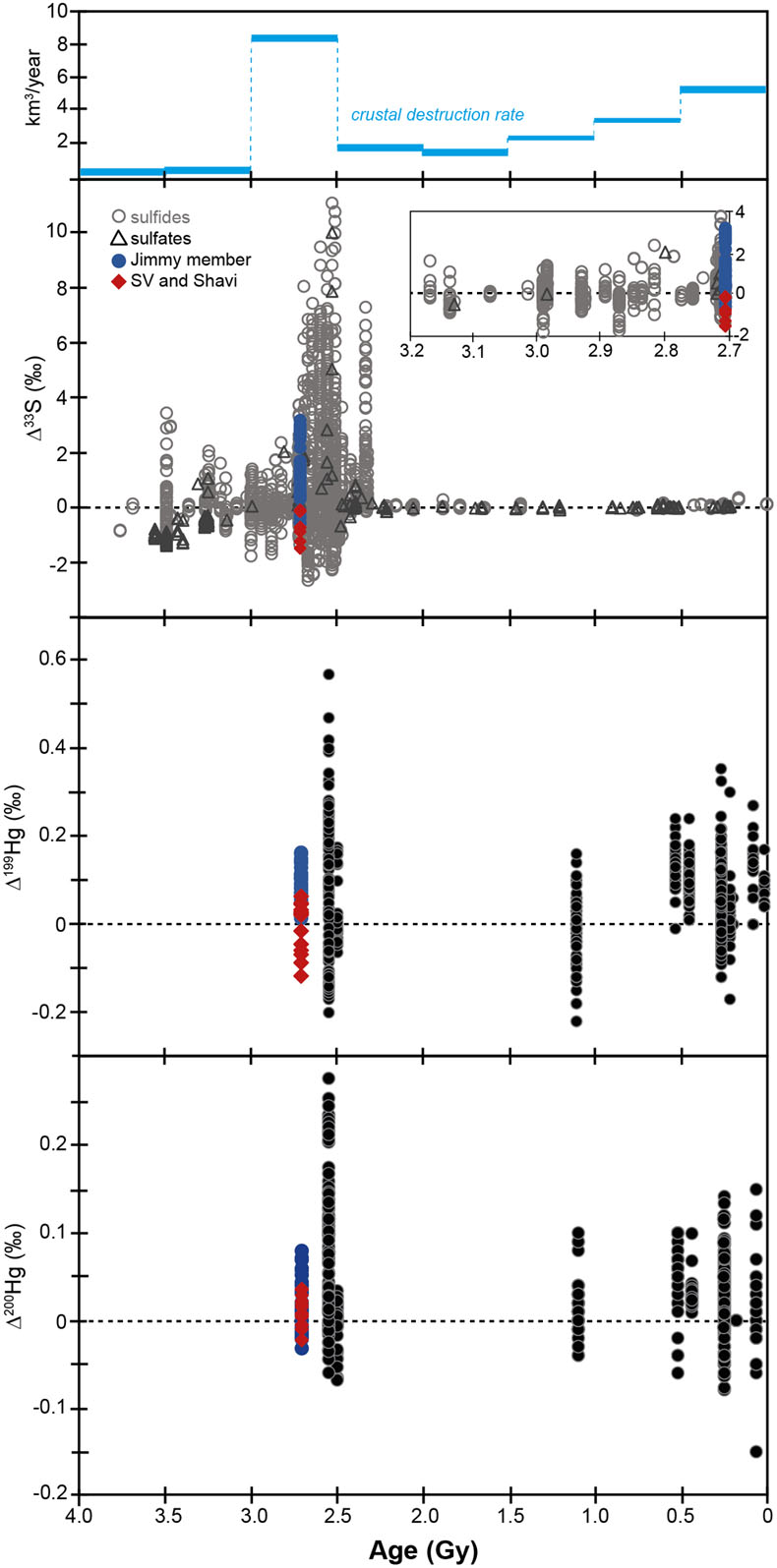
Figure 1 Temporal trends in S-MIF and Hg-MIF through time (updated from Farquhar et al., 2014
Farquhar, J., Zerkle, A.L., Bekker, A. (2014) 6.4 - Geologic and Geochemical Constraints on the Earth’s Early Atmosphere. In: Holland, H.D., Turekian, K.K. (Eds.) Treatise on Geochemistry. Second Edition, Elsevier, Oxford, 91–138.
, and Zerkle et al., 2020Zerkle, A.L., Yin, R., Chen, C., Li, X., Izon, G., Grasby, S. (2020) Anomalous fractionation of mercury isotopes in the Late Archean atmosphere. Nature Communications 11, 1709.
). Crustal destruction rates are modelled for 500 million year bins (Dhuime et al., 2018Dhuime, B., Hawkesworth, C.J., Delavault, H., Cawood, P.A. (2018) Rates of generation and destruction of the continental crust: implications for continental growth. Philosophical Transactions of the Royal Society A 376.
).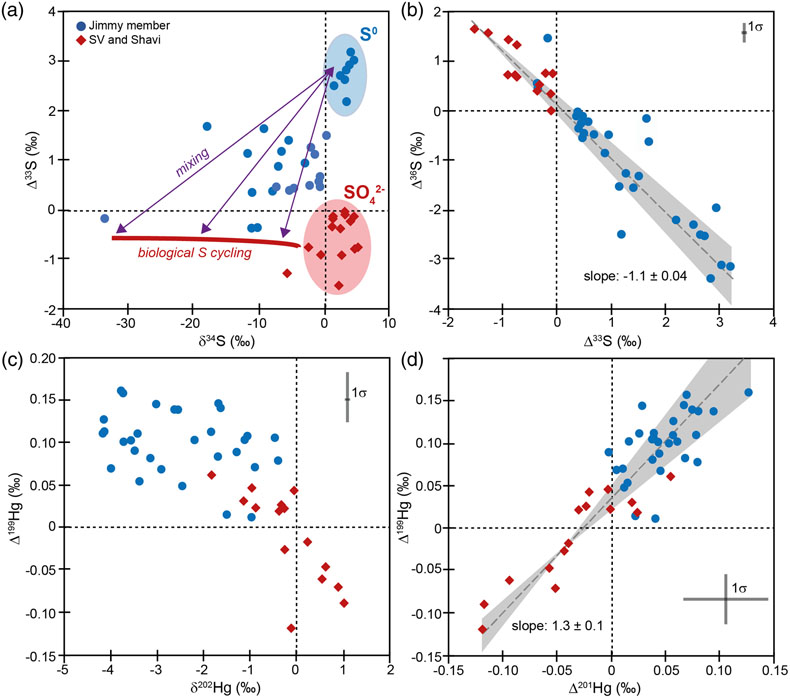
Figure 2 (a-d) Cross plots of S-MIF and Hg-MIF values. Panel (a) includes interpretations of S-MIF based on the conventional view of sulfur exit channels (but see Harman et al., 2018
Harman, C.E., Pavlov, A., Babikov, D., Kasting, J.F. (2018) Chain formation as a mechanism for mass-independent fractionation of sulfur isotopes in the Archean atmosphere. Earth and Planetary Science Letters 496, 238–247.
, for an alternative view). Panels (b) and (d) include orthogonal data regressions, showing the calculated linear slopes (gray dashed line) and 3σ confidence intervals (gray blue area). The Δ36S/Δ33S slope is consistent with the Archean reference array (Ono et al., 2009Ono, S., Beukes, N.J., Rumble, D. (2009) Origin of two distinct multiple-sulfur isotope compositions of pyrite in the 2.5 Ga Klein Naute Formation, Griqualand West Basin, South Afric. Precambrian Research 169, 48–57.
); the Δ199Hg/Δ201Hg slope is consistent with production of odd number Hg-MIF during Hg2+ photo-reduction (Bergquist and Blum, 2007Bergquist, B.A., Blum, J.D. (2007) Mass-dependent and -independent fractionation of Hg isotopes by photoreduction in aquatic systems. Science 318, 417–420.
).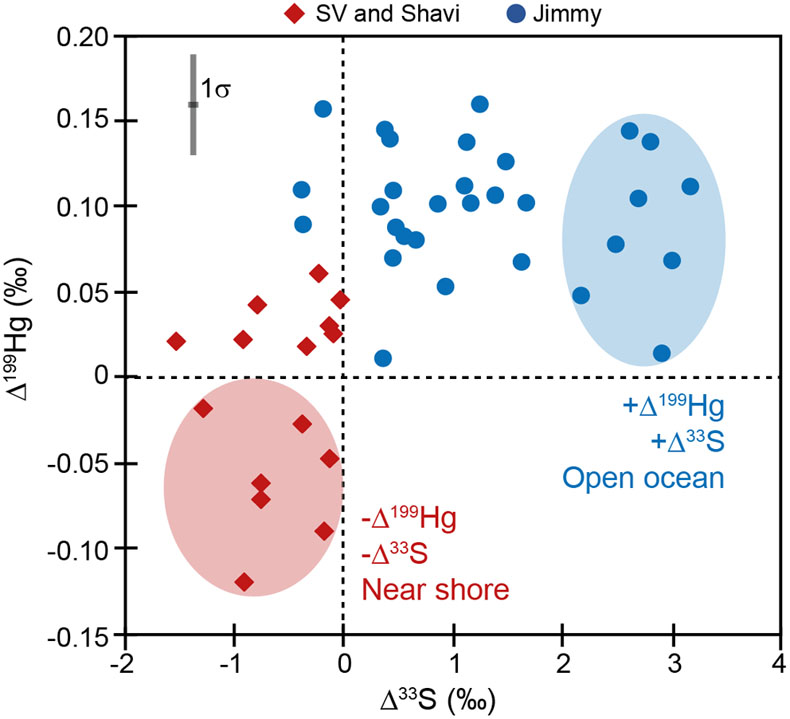
Figure 3 Trends in S-MIF versus Hg-MIF, with associated interpretations based on comparison with modern sedimentary Hg-MIF values.


